“Beware the Gray Ghost”
Story Dennis O’Flaherty & Tom Ruegger
Teleplay Garin Wolf & Tom Ruegger
Directed by Boyd Kirkland
Episode #018
Supervising Composer Shirley Walker
Music Composed by Carl Johnson
Animation Services by Spectrum Animation Studio
Original Airdate — November 4th, 1992
Plot: A series of bombings copy the plot of one of Bruce Wayne’s favorite shows when he was a child, so Batman seeks the aid of the actor who played his childhood hero. Meta-commentary ensues.
Holy crap you guys. One of the difficulties with doing a rewatch like this, and why I double up most episodes, is because there isn’t always a lot to say about any individual episode. There are only so many ways to say “child abduction is bad” or “Nostromos is kind of a sucky villain.” But then there’s this episode. Buckle up.
Before we even get to the really crazy parts, on a purely textual level, this is a fascinating episode. We’ve already seen, in “The Underdwellers,” “Be a Clown,” and “I’ve Got Batman in My Basement,” how Batman inspires children to be brave. Here we see how Bruce himself was inspired to be a superhero when he was a little boy.
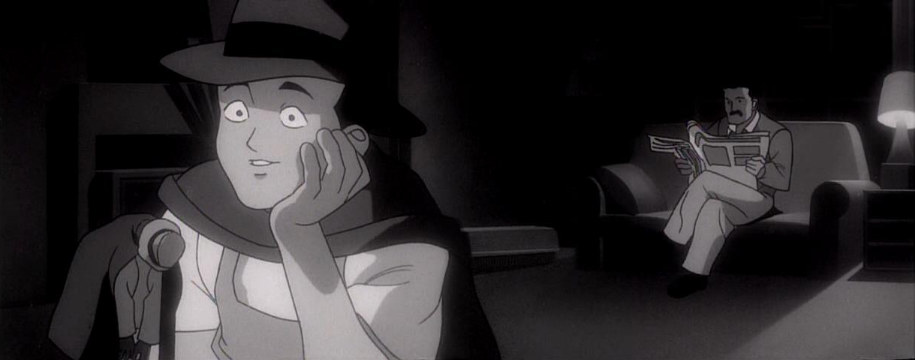
A simple flashback shows how Bruce associates the adventures of the Gray Ghost with the loving arms of his father (Kevin Conroy’s compassionate take replacing Richard Moll’s voice of disappointment from “Nothing to Fear.”) When Bruce then lost his father, he clearly looked for surrogate figures to replace him; Alfred, of course, and the Gray Ghost.
However, Batman’s attachment to the Gray Ghost comes off closer to obsession. He has trouble differentiating between Simon Trent, the actor, and the Gray Ghost, the fictional character Trent played decades ago. Batman leaves notes for Trent that are addressed to the Ghost. He seems insulted when Trent explains that, no, he’s not really a costumed superhero, and he has a Grey Ghost shrine hidden in a closet of the Batcave. The entire Batcave itself, we learn, is in fact a recreation of the Gray Ghost’s Lair, reinforcing the theory that “Batman” is a child’s idea of the best way to fight crime and save the world.
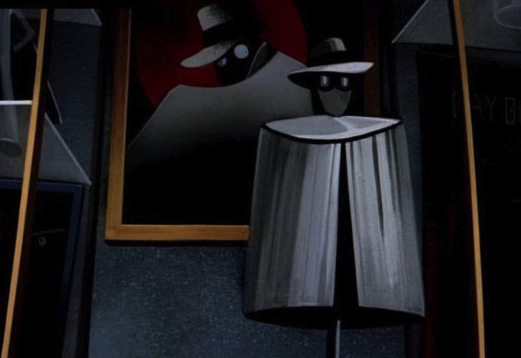
The contrast here is to the villain of the piece, Ted Dymer, aka the Mad Bomber, another man stuck in arrested development. Dymer is obsessed with toys and nostalgia, and is caught in an endless loop of using toys to commit crimes so that he can buy more toys. Like Batman, he looks to the past for inspiration rather than attempt to innovate, and his love of toys is shown to be empty, as he ends up destroying his own stuff in a failed attempt to kill Batman and Trent, just as Poison Ivy destroys her own plants. Actually, Poison Ivy took her defeat better.
The third point of this triangle is Simon Trent himself. Rather than immersing himself in nostalgia, Trent is haunted and trapped by his past. He wants to put it behind him, because he’s worried about paying his rent and getting other acting roles. Trent finds Batman’s inability to tell the difference between fiction and reality rightfully terrifying, and his wrinkled, weathered face and gray hair show someone beaten by time, a truly empathetic character. He’s the first true adult here.

Which is why the resolution of his character arc is so odd. In the end, Trent finds new life by embracing his history and wearing his costume again with pride. This creates dueling morals. The villain is bad because he cannot put away his childish things. But the heroes are good because they revel in them. How does that make any sense?
Well, it doesn’t, on a textual level. But let’s get meta.
Batman: the Animated Series takes place in a world where Batman and Robin are the only superheroes (at least for the first season). There was no Justice Society precursor to Batman, no history of Batmen through the centuries. Therefore, to do an episode where Batman teams up with an older hero, he has to team up with a “fictional” one who represents the heroes that came before. So the Gray Ghost stands in for all of the pulp heroes that inspired Bob Kane and Bill Finger to create Batman in 1939, particularly Zorro and the Shadow.
The character design and the style of his show mark the Gray Ghost as a character out of 1940s film serial. His theme music is upbeat horns, similar to the Indiana Jones theme. The Gray Ghost poster is an art deco piece of him towering over the city. And in another bit of meta-commentary, the opening of his TV show is a beat for beat recreation of the Batman: the Animated Series intro, (shot of sky, pan down to crooks, hero beats up crooks, hero poses dramatically) with the addition that a narrator and title card actually tell you the name of the goddamn show.
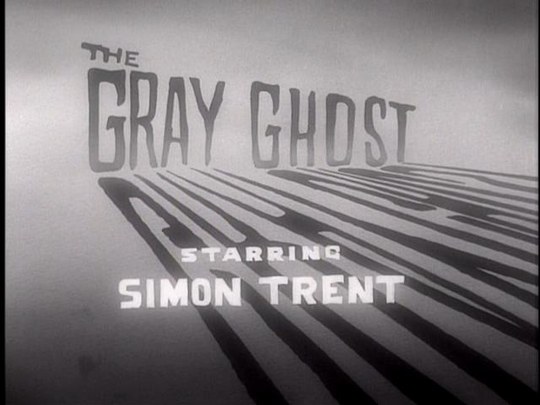
Looked at in that light, as the Gray Ghost representing all the proto-Batmen, this episode can be read as a passing of the torch, one generation of hero paying respect to the last. We’re see the transition from pulp heroes in stylized outfits to heroes in full costumes with masks and themed boomerangs. We also see that Batman has effectively replaced the older pulp heroes in the public consciousness so that they are forgotten. But Batman hasn’t forgotten, and Batman still thinks they can help.
Okay, still with me? Because where the show goes nuts is the casting. Adam West plays Simon Trent, and Batman: the Animated Series creator Bruce Timm plays Ted Dymer, the villain. So this episode isn’t just Batman teaming up with his childhood hero, and Batman teaming up with the Shadow, it’s ALSO Batman teaming up with the campy 1960s Batman to beat up the creator of the very show you are watching!
Let that sink in.
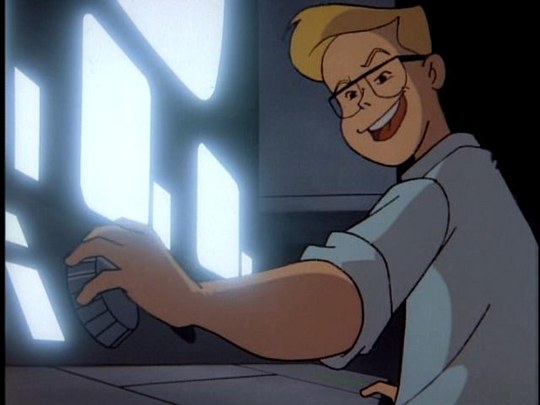
To be clear the Mad Bomber isn’t just voiced by Timm, he looks exactly like Timm. He’s not just any man-child. He is THE fanboy who created this show: someone obsessed with recreating the stories he loved as a child but with a need to make them darker by incorporating his Twilight Zone dolls and knocking the head off his Batman doll. He has literally turned remote cars based on the old Batmobile into weapons of mass destruction. But Dymer’s obsession with the past is also his weakness, since recreating stories makes him predictable, which is a neat bit of self-commentary about Timm’s stories.
Casting Adam West as the inspiration for Batman turns the whole series on its head. Since The Dark Knight Returns, at least, interpretations of Batman have been running away from the “Bam Pow” campiness of West’s Batman. The Animated Series, following the model of the Burton films, had also been trying to move away from the outright silliness of the older series, but this episode says, “you know what, we can be both silly and serious. Yes, we did an episode about a psychotic father kidnapping his daughter. But the father was invisible and called Mojo at the time. Let’s not get too full of ourselves.”
West, by the way, is fantastic in this episode. Simon Trent isn’t just a stand in for West himself, but for Christopher Reeve and George Reeves and every other actor who played a superhero then had trouble finding work afterwards. Adam West gives Trent a quiet dignity, even at his lowest, and I get a real sense of excitement hearing enjoyment creep back into his performance when Trent remembers that the Gray Ghost was meant to inspire children, and look at that, it did.

We can read Bruce Wayne’s evolving reaction to the Gray Ghost over the episode, going from hero worship to disillusionment and disgust, and then back to a qualified worship, as the way the creators of the Animated Series, and a lot of Batman fans in general, feel about the old show. As kids, they loved the adventure of the show. As teenagers, they hated it, feeling betrayed that the creators of that show did not take a vigilante who dresses up like a bat seriously enough. And as adults they love the show again, but for what it is, a very funny, silly take on a ridiculous premise. “Beware the Gray Ghost” is about this version, the ’90s version, of Batman looking to the goofy, campy 1966 version and saying, “I would not be what I am today without you.”
Three more notes.
Spectrum Studio provides a strangely off-model animation job for this episode. It is much more dynamic than usual, with brighter colors and a lot of energy in the chase sequences. But at the same time, everything is much more rubbery. The human reactions are bigger, the machines and sets bounce and bend, and when the Batmobile goes over a hill, it bends with the road. I’m not sure it was intentional, but it certainly adds to the episode’s theme that Batman: the Animated Series is not nearly as serious as it pretends to be.
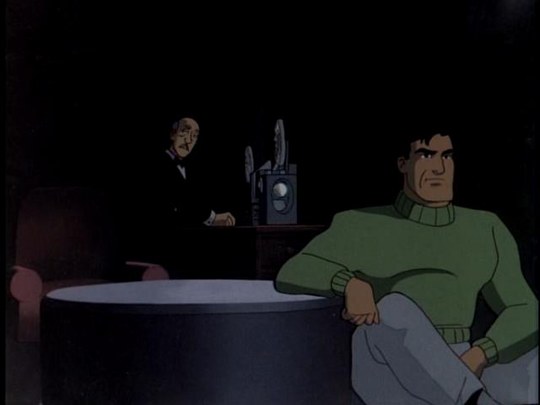
On a personal note, watching Batman feel nostalgic and watch his favorite childhood show while I am feeling nostalgic and watching my favorite childhood show is fucking trippy. I’m pretty sure if you held a mirror up at this moment, I’d fall into it forever.
And finally, in a blink and you’ll miss it cameo, at the end of the episode Simon Trent poses into front of a blow of up People (another fine Time-Warner product). At the top of the magazine there’s a plug for Matt Hagan, Man of a Million Faces. Hagan is also an actor, but his problems are very different, and much, much more dangerous. And we’re about to meet him.

Steven Padnick is a freelance writer and editor. By day. You can find more of his writing and funny pictures at padnick.tumblr.com.











Wow, I really like Your Batman TAS articles. I wished to say it for a long-long time.
1. Hedgehog Dan
Yeah, I don’t have a lot to add here, besides: “nice analysis,” which is basically just me wanting to say “Like,” or “+1.”
I never saw it as Batman being unable to distinguish reality from fantasy. I saw it as Batman trying to convince Trent to get over his resentment for the Gray Ghost because that was the only way he could get Trent to help him stop the bomber. He was saying, “Look, you’re more than just a struggling, washed-up actor, and the Gray Ghost was more than some crummy old show you hate. You have something inside you that made me believe heroes were real, that inspired me to become what I am. And that means you have the potential to be a hero for real.” Batman knows the difference between fantasy and reality, but he understands that fantasy — or symbols and legends, to put it in Christopher Nolan terms — can inspire people to make a difference in real life. And he understands the power that putting on a mask and a new persona can have.
Sure, some of it was disappointment that the actor he’d admired for so long fell short of his image of the man. But it wasn’t about actually believing the show had been real. It was about trying to show Trent how much good he’d done.
This is a terrific episode. Adam West’s performance was especially poignant because it was so true to life — at the time, he hadn’t yet had the career renaissance he’s had now, and a lot of the emotion he put into Trent’s lines probably came from his own darkest hours. It’s interesting how much life parallels art in terms of West’s comeback — although unlike The Gray Ghost, the ’66 Batman still hasn’t had a home video release.
Carl Johnson’s music is also top-notch. He does a great pastiche of the musical style of old adventure serials and shows, and the leitmotif for the toy-car bombs is great too. Johnson would go on to be the composer for Gargoyles.
This is one of my favorite episodes of the whole series. Adam West as the Gray Ghost is especially inspired. I know that Batman knows the Gray Ghost is just a tv show but was disappointed that Simon Trent didn’t realize how much he mattered. I didn’t know Timm was the bad guy in this episode that makes it even more meta than I thought.
I don’t know if it’s relevant or not, but I’ll say it anyway.
The big thing I realized during my recent bat-movie/bat-series marathon is that Tim Burton’s movies, although they were dark, wisely never attempted to put Batman in any kind of real-world context… as the man-children are doing now with their almost insane insistence on everything being ‘realistic’.
Burton didn’t even elude to Zorro playing at the theatre that fateful night. He just presented Batman as a disturbed individual who crafts a strange persona to assuage his own pain. That’s all, folks. No ‘symbol’, and no trying to put him in context with anything. Just a slightly psychotic guy and his personal fight against evil. For that reason alone, I prefer his movies over just about everything else in the Batman pathos, including TAS.
HI!
I love the Batman the Animated Series Rewatch. Been following it week by week. It is also one of my favorite series.
You failed to mention, in this particular episode (which I love) that it is almost the same story as the Flash episode Ghost in the machine, which is only a couple of years older.
I love both episodes each by its own merits. But even the Gray Ghost suit looks almost exactly like The Ghost’s.
@6: Actually the hero in that Flash episode, the one with a similar costume to the Gray Ghost, was called Nightshade. The Ghost was his archenemy and didn’t wear a costume. Also, he was a real ’50s crimefighter, not a TV performer. Rather than someone who’d inspired Barry Allen to become the Flash, he was a hero that Barry had never heard of before, and it was momentous for him to discover he wasn’t the only one of his kind (although Nightshade was a nonpowered hero). Also, Nightshade wore a full-face mask, not just goggles, in order to conceal the fact that he was African-American.
So while there are a few points of similarity, they aren’t the same story by any means.
@7: How ’bout a “Flash” re-watch? :)
Regarding this episode – I wish you’d quit living in my head Christopher – I always thought the same thing about the Grey Ghost/Batman dynamic in that episode. I look at the Grey Ghost like “I Am Not Spock” -era Nimoy or SNL-Get-A-Life Shatner, and Batman is trying to show him that he did some good.
Great review. I can see why it took you a while to write this one! “Beware the Gray Ghost” is a great episode, with so many levels to it. I’d never realized the villain actually LOOKED like Bruce Timm. Trippy indeed!
And that damn bending Batmobile. I HATE that moment. I don’t need the cartoon physics to break just to remember that I’m watching an animated show! As you say, it probably wasn’t intentional. But for a show with such style and grace, that moment always bothers me! Not enough not to love the episode, of course. :-)
According to “Animato” magazine the animation was handled by a studio called Dust, even though spectrum was credited. It’s possible that they outsourced it.